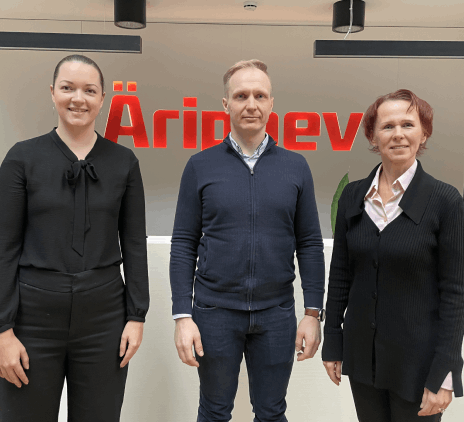-
Other audit services
We help clients with the application and use of foreign financial aid of EU and other funds and help prepare financial reports.
-
Audit calculator
The calculator will answer if the company's sales revenue, assets or number of employees exceed the limit of an inspection or audit.
-
Payroll and related services
We perform payroll accounting for companies whether they employ a few or hundreds of employees.
-
Tax accounting
Grant Thornton Baltic's experienced tax specialists support accountants and offer reasonable and practical solutions.
-
Reporting
We prepare annual reports in a timely manner. We help to prepare management reports and various mandatory reports.
-
Consolidation of financial statements
Our experienced accountants and advisors help you prepare consolidation tables and make the consolidation process more efficient.
-
Consultancy and temporary staff
Our experienced specialists advise on more complex accounting transactions, rectify poor historic accounting, and offer the temporary replacement of an accountant.
-
Outsourced CFO service
Our CFO service is suitable for companies of all sizes and in all industries. We offer services to our clients in the required amount and competences.
-
Assessment of accounting processes
We help companies to implement accounting practices that are in compliance with local and international standards.
-
Accounting services for small businesses
We offer affordable service for small businesses. We help organize processes as smartly and cost-effectively as possible.
-
Cryptocurrency accounting
We keep up with blockchain technology to serve and advise crypto companies. We are supported by a network of colleagues in 130 countries.
-
Trainings and seminars
Our accountants have experience in all matters related to accounting and reporting. We offer our clients professional training according to their needs.

-
Business advisory
We offer legal support to both start-ups and expanding companies, making sure that all legal steps are well thought out in detail.
-
Fintech advisory
Our specialists advise payment institutions, virtual currency service providers and financial institutions.
-
Corporate advisory
We advise on legal, tax and financial matters necessary for better management of the company's legal or organizational structure.
-
Transaction advisory
We provide advice in all aspects of the transaction process.
-
Legal due diligence
We thoroughly analyze the internal documents, legal relations, and business compliance of the company to be merged or acquired.
-
In-house lawyer service
The service is intended for entrepreneurs who are looking for a reliable partner to solve the company's day-to-day legal issues.
-
The contact person service
We offer a contact person service to Estonian companies with a board located abroad.
-
Training
We organize both public trainings and tailor made trainings ordered by clients on current legal and tax issues.
-
Whistleblower channel
At Grant Thornton Baltic, we believe that a well-designed and effective reporting channel is an efficient way of achieving trustworthiness.

-
Business model or strategy renewal
In order to be successful, every company, regardless of the size of the organization, must have a clear strategy, ie know where the whole team is heading.
-
Marketing and brand strategy; creation and updating of the client management system
We support you in updating your marketing and brand strategy and customer management system, so that you can adapt in this time of rapid changes.
-
Coaching and development support
A good organizational culture is like a trump card for a company. We guide you how to collect trump cards!
-
Digital services
Today, the question is not whether to digitize, but how to do it. We help you develop and implement smart digital solutions.
-
Sales organisation development
Our mission is to improve our customers' business results by choosing the right focuses and providing a clear and systematic path to a solution.
-
Business plan development
A good business plan is a guide and management tool for an entrepreneur, a source of information for financial institutions and potential investors to make financial decisions.
-
Due diligence
We perform due diligence so that investors can get a thorough overview of the company before the planned purchase transaction.
-
Mergers and acquisitions
We provide advice in all aspects of the transaction process.
-
Valuation services
We estimate the company's market value, asset value and other asset groups based on internationally accepted methodology.
-
Forensic expert services
Our experienced, nationally recognized forensic experts provide assessments in the economic and financial field.
-
Business plans and financial forecasts
The lack of planning and control of cash resources is the reason often given for the failure of many businesses. We help you prepare proper forecasts to reduce business risks.
-
Outsourced CFO service
Our CFO service is suitable for companies of all sizes and in all industries. We offer services to our clients in the required amount and competences.
-
Reorganization
Our experienced reorganizers offer ways to overcome the company's economic difficulties and restore liquidity in order to manage sustainably in the future.
-
Restructuring and reorganisation
We offer individual complete solutions for reorganizing the structure of companies.
-
Corporate taxation
We advise on all matters related to corporate taxation.
-
Value added tax and other indirect taxes
We have extensive knowledge in the field of VAT, excise duties and customs, both on the national and international level.
-
International taxation
We advise on foreign tax systems and international tax regulations, including the requirements of cross-border reporting.
-
Transfer pricing
We help plan and document all aspects of a company's transfer pricing strategy.
-
Taxation of transactions
We plan the tax consequences of a company's acquisition, transfer, refinancing, restructuring, and listing of bonds or shares.
-
Taxation of employees in cross-border operations
An employee of an Estonian company abroad and an employee of a foreign company in Estonia - we advise on tax rules.
-
Tax risk audit
We perform a risk audit that helps diagnose and limit tax risks and optimize tax obligations.
-
Representing the client in Tax Board
We prevent tax problems and ensure smooth communication with the Tax and Customs Board.
-
Taxation of private individuals
We advise individuals on personal income taxation issues and, represent the client in communication with the Tax and Customs Board.
-
Pan-Baltic tax system comparison
Our tax specialists have prepared a comparison of the tax systems of the Baltic countries regarding the taxation of companies and individuals.
-
Internal audit
We assist you in performing the internal audit function, performing internal audits and advisory work, evaluating governance, and conducting training.
-
Internal Audit in the Financial Services Sector
We provide internal audit services to financial sector companies. We can support the creation of an internal audit function already when applying for a sectoral activity license.
-
Audit of projects
We conduct audits of projects that have received European Union funds, state aid, foreign aid, or other grants.
-
Prevention of money laundering
We help to prepare a money laundering risk assessment and efficient anti-money laundering procedures, conduct internal audits and training.
-
Risk assessment and risk management
We advise you on conducting a risk assessment and setting up a risk management system.
-
Custom tasks
At the request of the client, we perform audits, inspections and analyzes with a specific purpose and scope.
-
External Quality Assessment of the Internal Audit Activity
We conduct an external evaluation of the quality of the internal audit or provide independent assurance on the self-assessment.
-
Whistleblowing and reporting misconduct
We can help build the whistleblowing system, from implementation, internal repairs and staff training to the creation of a reporting channel and case management.
-
Information security management
We provide you with an information security management service that will optimise resources, give you an overview of the security situation and ensure compliance with the legislation and standards.
-
Information security roadmap
We analyse your organisation to understand which standards or regulations apply to your activities, identify any gaps and make proposals to fix them.
-
Internal audit of information security
Our specialists help detect and correct information security deficiencies by verifying an organization's compliance with legislation and standards.
-
Third party management
Our specialists help reduce the risks associated with using services provided by third parties.
-
Information security training
We offer various training and awareness building programmes to ensure that all parties are well aware of the information security requirements, their responsibilities when choosing a service provider and their potential risks.
-
Digital Operational Resilience Act (DORA)
We will help you create a DORA implementation model that meets your company's needs and ensures that you meet the January 2025 deadline.

-
ESG advisory
We help solve issues related to the environment, social capital, employees, business model and good management practices.
-
ESG audit
Our auditors review and certify sustainability reports in line with international standards.
-
Sustainable investments
We help investors conduct analysis of companies they’re interested in, examining environmental topics, corporate social responsibility and good governance practices.
-
Sustainable tax behaviour
Our international taxation specialists define the concept of sustainable tax behaviour and offer services for sustainable tax practices.
-
ESG manager service
Your company doesn’t necessarily need an in-house ESG manager. This role can also be outsourced as a service.

-
Recruitment services – personnel search
We help fill positions in your company with competent and dedicated employees who help realize the company's strategic goals.
-
Recruitment support services
Support services help to determine whether the candidates match the company's expectations. The most used support services are candidate testing and evaluation.
-
Implementation of human resource management processes
We either assume a full control of the launch of processes related to HR management, or we are a supportive advisory partner for the HR manager.
-
Audit of HR management processes
We map the HR management processes and provide an overview of how to assess the health of the organization from the HR management perspective.
-
HR Documentation and Operating Model Advisory Services work
We support companies in setting up HR documentation and operational processes with a necessary quality.
-
Employee Surveys
We help to carry out goal-oriented and high-quality employee surveys. We analyse the results, make reports, and draw conclusions.
-
HR Management outsourcing
We offer both temporary and permanent/long-term HR manager services to companies.

-
Digital strategy
We help assess the digital maturity of your organization, create a strategy that matches your needs and capabilities, and develop key metrics.
-
Intelligent automation
We aid you in determining your business’ needs and opportunities, as well as model the business processes to provide the best user experience and efficiency.
-
Business Intelligence
Our team of experienced business analysts will help you get a grip on your data by mapping and structuring all the data available.
-
Cybersecurity
A proactive cyber strategy delivers you peace of mind, allowing you to focus on realising your company’s growth potential.
-
Innovation as a Service
On average, one in four projects fails and one in two needs changes. We help manage the innovation of your company's digital solutions!

Author: Marko Rebane
Food synthesizers, halo environments and a number of other exciting gadgets seen on TV seem like an unattainable dream a Star Trek fan might have come up with. But for how long?
If someone has an idea that solves a real problem and is needed, it’s likely only a matter of time before the new possibilities enabled by technology and science and market demand spur innovation and make the fantasy a reality. After all, touchscreens, voice-activated devices, automatic doors, GPS, video conferencing, real-time translation and many other “futuristic” technologies were once the realm of fantasy, existing only in the minds of writers for Star Trek.[1]
Innovation as inevitability
Planning, designing and visualising future events, sharing knowledge, cooperation and the pursuit of success and happiness are innate human traits. The outcome: is a globalised economy, increasing development of technology, accelerated changes in society, and sociocultural shifts. It also means shorter and shorter product life cycles and lifespans for corporate strategies. Market participants themselves constantly create innovation and demand it from others.
One of the engines of capitalism is undoubtedly optimism, but it doesn’t always work in our favour. Emotions and cognitive errors are inevitably part of being human. At times, that can include excessive optimism – the better-than-average effect that often blinds entrepreneurs to competition and changes. The observation that 90% of drivers consider themselves better than average is probably familiar to you from research.[2] Similarly, Nobel Prize winner in economics Daniel Kahneman has noted from his interviews that 80% of the founders of innovative start-ups believe that their fate rests almost entirely in their own hands.[3]
Actually that’s not the case and it would be easy to be caught napping and miss innovation by our competitors taking place right under our noses. Only 71 of the companies originally on the Fortune 500 list published in 1954 are still on the list today.[4] In other words, just 14% of the world’s biggest and most successful corporations were able to survive long enough for an employee to complete their whole career cycle there and retire.[5]
Catalysing innovation and introducing a new product or service to the market doesn’t necessarily depend on having great personal resources and making an arduous effort. Anyone with a good product idea but who doesn’t want to take on too much risk and responsibility can go to Quirky.com and realise the whole process or development and marketing through crowdsourcing.
Innovation starts from the person themselves
The entrepreneur and innovator Jay Alan Samit has built million-dollar businesses, turned whole economic sectors upside down, revolutionised government institutions, and has been in the vanguard of global trends for over three decades now.
Samit calls himself an “intrapreneur”. An intrapreneur is an entrepreneur who summons forth revolutionary changes in organisations, doesn’t wait until the company is attacked by outside forces. Any sustainable changes have to start from within the individual themselves. “Everyone thinks of changing the world, but no one thinks of changing themselves,” Tolstoy once said. Albert Einstein’s achievements were predicated on the view that:“The world as we have created it is a process of our thinking. It cannot be changed without changing our thinking.”
Samit says that radical change is summoned forth by people who understand how to analyse their internal value chain, to establish their unique skills and abilities and who then analyse sectors of the economy to find possibilities for revolutionary innovation.[6]
Innovation requires a favourable environment and leadership
Once an organisation realises that changes are needed and wants to summon forth the changes, it will need to create a conducive organisational culture along with the appropriate values, put an innovation strategy in place and build the innovation system (processes, methods and tools). Managers have to reflect a supportive attitude toward innovation, and make it possible (leadership, training, time, resources, creation of teams etc.) and recognise employees for contributing to it. In innovation organisations, employees learn to value themselves more, they have higher inner motivation, and they are more loyal, flexible and productive.[7]
For example, Grant Thornton’s brand-new CEO Peter Bodin has made a special point of developing a culture based on cooperation and innovation in the organisation, supporting the growth and positive changes among Grant Thornton’s member companies. “I’ve always believed that a sustainably successful business is based on right management, people and culture. My job is to create an environment at Grant Thornton that enables our member companies sand people to work together and create innovative solutions,” says Bodin.
Vijay Govindrajan, the author of The Other Side of Innovation, sees three main traps for an organisation’s success. The first is the resource trap – companies invest too much into systems that are obsolete, ignoring new possibilities. The other is a psychological trap where long planning cycles do prioritise anything that was the foundation of organisation’s past success. The third trap lies in insufficient readiness for future developments. Past mistakes are also called the Rochester mentality – after Eastman Kodak, which missed the digital revolution (they were headquartered in Rochester, NY).
There’s rarely anything totally new under the Sun
Innovation is surrounded by a number of myths. Often it’s believed that innovation is something mystical that requires a Eureka moment, great resources, lack of restrictions for high-flying creative work, the involvement of the best experts in the field or a team working in total mind-meld.[8]
Actually there’s nothing new under the sun. Tom Freston, former president and CEO of MTV, has come up with a pretty prosaic but apt definition for innovation: it’s where you take two existing things and put them together in a new way. So if you take music and video and combine them in a new way, the outcome is a music video, a completely new market segment and significantly changed industry.
Most innovation is built on the successes that came before it and it is usually simply a new combination of the existing elements, the fruits of a disciplined approach and working cooperation. Often the answer to the problems of one industry lies in some other unrelated field – one only needs to be observant and have a methodical approach to the problem.
The applications of innovation are broad
Business can be viewed as the sum of links that generate value added: development, design, production, marketing and sales. To make business more effective, it is enough to focus and summon forth positive changes and innovation in just one link of the value chain. By concatenating and combining many different innovations across the value chain, the company will have likely created a sustainable competitive edge.
NASA has shared its technological patents with the public for the purpose of developing new useful products via crowdsourcing. Nike and Converse didn’t invent athletic shoes; they merely created something distinctive and superior through product design. Amazon has realised that the customer relationship is a genuine asset that can be aspired to in the digital distribution business (Amazon Prime programme).[9] Apple’s success demonstrates the competitive edge of integral solutions and ecosystems (iPhone, iTunes, Apple Watch). Use of YouTube’s free infrastructure for developing and transmitting market content has become an indispensable tool for many businesses.
Thus, questions of the different facets of business activity could be in the centre of innovation: where money comes into the business and how to ask for it from customers (business model innovation), is it possible to create value added in cooperation with others (networking innovation), how the company's key persons and assets should be organised and structured (structural innovation) or what is the company’s unique asset in production, service or supply (process innovation). Widespread forms of innovation include focusing on the functionality of the product or service, its uniqueness or quality, or connecting products into a united system (product/service capability and system innovation). Innovation offers abundant potential when aimed at the company's customers: how to offer support and leverage one’s offer (support services innovation), which channels to use to take the offer to the customer and user (sale channel innovation), how to portray the offer and the corporate identity (brand innovation), and how to create meaningful experiences for the client (client experience innovation). [10]
A beneficial change can turn into a billion-dollar business
The keyword of innovation is “beneficial change”. Change in oneself, the organisation, an industry, society, state or the whole world. Changes need management, a methodical framework and discipline to realise changes from the level of an idea to a positive success experience. Considering today’s open economy and mass markets, even the smaller innovation carried out can become amplified into the next million-dollar business.
[1] https://qz.com/766831/star-trek-real-life-technology/ (06.06.2018)
[2] http://www.sciencedirect.com/science/article/pii/0001691881900056(06.06.2018)
[3] Daniel Kahneman. “Thinking, Fast and Slow”. Penguin Books Ltd, 2012.
[4] Dane Strangler, Sam Arbesman. “What Does Fortune 500 Turnover Mean?”. Ewing Marion Kauffman Foundation, 2012.
[5] Antonio Regaldo. “Technology Is Wiping Out Companies Faster Than Ever”. MIT Technology Review, 2013.
[6] Jay Samit. “Disrupt Yourself”. Flatiron Books, 2015.
[7] Meelis Lang. “Innovatsiooni juhtimine” (Managing innovation). Subject taught at Tallinn University of Technology, 2018.
[8] Ibid.
[9] Jay Samit. Op. cit.
[10] Larry Keeley, Helen Walters, Ryan Pikkel, Brian Quinn. “Ten Types of Innovation: The Discipline of Building Breakthroughs”. Wiley, 2013.






